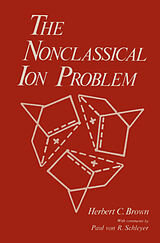The Nonclassical Ion Problem
Einband:
Kartonierter Einband
EAN:
9781461341208
Untertitel:
Englisch
Genre:
Maschinenbau
Autor:
Herbert C. Brown
Herausgeber:
Springer US
Auflage:
1977
Anzahl Seiten:
328
Erscheinungsdatum:
12.10.2011
ISBN:
1461341205
In the early 1950s it was proposed that the cationic centers of carboniun ions in the usual solvolytic media could diminish their electron deficiency by interacting with the
Inhalt
1. That Fascinating Nonclassical Ion Problem.- 1.1. Introduction.- 1.2. Origins.- 1.3. The Nonclassical Ion Era.- 1.4. Steric Assistance.- 1.5. An Alternative Interpretation.- 1.6. The Rococo Period of Carbonium Ion Structures.- 1.7. Difficulties in Challenging an Accepted Theory.- 1.8. Further DifficultiesA Soft Theory.- 1.9. Still Further DifficultiesSelective Reviews.- 1.10. Conclusion.- Comments.- 2. Steric Assistance in Solvolytic Processes.- 2.1. Introduction.- 2.2. Steric Assistance in the Solvolysis of Highly Branched Alkyl Derivatives.- 2.3. Steric Assistance in the Relative Effects of Methyl and tert-Butyl Groups.- 2.4. Steric Effects in Norbornyl Derivatives.- 2.5. Steric Effects in Ring Systems.- 2.6. Conclusion.- Comments.- 3. ?ParticipationA Factor in Fast Rates?.- 3.1. Introduction.- 3.2. n-, ?- and ?-Participation.- 3.3. ?-Participation and Fast Rates.- 3.4. ?-Participation vs. Steric Assistance.- 3.5. Steric AssistanceNot ?-Participation.- 3.6. The Fast Rates of Exo-Norbornyl and Cyclopropylcarbinyl.- Comments.- 4. Carbon-Bridged Cations.- 4.1. Introduction.- 4.2. What Is a Nonclassical Ion?.- 4.3. ?-Bridging vs. Hyperconjugation.- 4.4. Static Classical, Equilibrating Classical, or ?-Bridged Cations.- 4.5. Stereochemistry and ?-Bridged Cations.- 4.6. ?-and Aryl-Bridged Cations.- 4.7. Conclusion.- Comments.- 5. The Cyclopropylcarbinyl Cation.- 5.1. Introduction.- 5.2. Exceptionally Fast Rates of Solvolysis.- 5.3. Rearrangements in the Solvolysis of Cyclopropylcarbinyl Derivatives.- 5.4. ?-Bridged Structures for the Cation.- 5.5. Stereochemical Characteristics.- 5.5. Conclusion.- Comments.- 6.The 2-Norbornyl Cation.- 6.1. Introduction.- 6.2. Nonclassical Structures for the 2-Norbornyl Cation.- 6.3. Basic Facts.- 6.4.Transition State or Intermediate.- 6.5. Equilibrating Cations.- 6.6. Are Exo Rates Unusually Fast?.- 6.7. Do the High Exo:Endo Rate Ratios Require ?-Bridged Cations?.- 6.8. Do the High Exo:Endo Product Ratios Require ?-Bridged Cations?.- 6.9. Theoretical and Empirical Solutions.- 6.10. Conclusion.- Comments.- 7. Stabilized 2-Norbornyl Cations.- 7.1. Introduction.- 7.2. The Gassman-Fentiman Approach.- 7.3. Exo:Endo Rate Ratios in 2-p-Anisyl-2-norbornyl.- 7.4. Exo:Endo Rate Ratios in 2-p-Anisyl-2-camphenilyl.- 7.5. Exo:Endo Product Ratios.- 7.6. Goering-Schewene Diagrams.- 7.7. Other 2-p-Anisyl Systems.- 7.8. Other Stabilized Systems.- 7.9. The Selectivity Principle and the 2-Norbornyl Problem.- 7.10. Conclusion.- Comments.- 8. Exo:Endo Rate Ratios as a Steric Phenomenon.- 8.1. Introduction.- 8.2. Steric Characteristics of the Norbornyl System.- 8.3. Steric Characteristics of the 7,7-Dimethylnorbornyl System.- 8.4. Steric Hindrance to Ionization.- 8.5. Misconceptions.- 8.6. Steric Hindrance to Ionization and the Foote-Schleyer Correlation.- 8.7. Steric Effects in U-Shaped Systems.- 8.8. Exo:Endo Rate and Product Ratios as a Steric Phenomenon.- 8.9. Conclusion.- Comments.- 9. Equilibrating Tertiary 2-Norbornyl Cations.- 9.1. Introduction.- 9.2. Theoretical Considerations.- 9.3. The 1,2-Di-p-anisyl-2-norbornyl Cation.- 9.4. The 1,2-Diphenyl-2-norbornyl Cation.- 9.5. The 1,2-Dimethyl-2-norbornyl System.- 9.6. Conclusion.- Comments.- 10. Effect of Increasing Electron Demand.- 10.1. Introduction.- 10.2. Basic Considerations.- 10.3. Electron Demand in ?-Systems.- 10.4. Electron Demand in Cyclopropylcarbinyl Systems.- 10.5. Electron Demand in 2-Norbornyl Systems.- 10.6. Increasing Electron Demand in Secondary 2-Norbornyl.- 10.7. Extrapolation of Data from the Tertiary to theSecondary Systems.- 10.8. Conclusion.- Comments.- 11. Substituent and Structural Effects in 2-Norbornyl.- 11.1. Introduction.- 11.2. Secondary vs. Tertiary 2-Norbornyl Cations.- 11.3. Substituents as a Probe for Charge Delocalization.- 11.4. The Search for Charge Delocalization at C6.- 11.5. The Search for Charge Delocalization at C2.- 11.6. The Search for Charge Delocalization at C1.- 11.7. Deuterium as a Substituent.- 11.8. Deactivating Substituents.- 11.9. Structural Modifications.- 11.10. Conclusion.- Comments.- 12. Capture of Unsymmetrical 2-Norbornyl Cations.- 12.1. Introduction.- 12.2. Deamination of 2-Norbornylamine.- 12.3. Attempted Trapping of Unsymmetrical Cations in Solvolytic Processes.- 12.4. Capture of Unsymmetrical Cations in Solvolytic Processes.- 12.5. Additions to 2,3-Dideuterionorbornene.- 12.6. Addition of Deuterium Chloride to Norbornene.- 12.7. Addition of Deuteriotrifluoroacetic Acid to Norbornene.- 12.8. Addition of Perdeuterioacetic Acid to Norbornene.- 12.9. Resumé.- 12.10. Conclusions.- Comments.- 13. Equilibrating Cations under Stable Ion Conditions.- 13.1. Introduction.- 13.2. Equilibrating Cations.- 13.3. Applicability of Results to Solvolysis.- 13.4. 13C NMR Shifts as a Measure of Charge Delocalizations.- 13.5. Nonadditivity of 13C Shifts as a Basis for Nonclassical Structures.- 13.6. PMR Spectra.- 13.7. ESCA Spectra.- 13.8. Cation Stabilities.- 13.9. Conclusion.- Comments.- 14. New ConceptsNew Systems.- 14.1. Introduction.- 14.2. The Hyperconjugative Model.- 14.3. The Exo-6-H Participation Model.- 14.4. The Search for a Stereoelectronic Contribution.- 14.5. New Proposed ?-Bridged Systems.- 14.6. Conclusion.- Comments.- 15. Final Comments.- 15.1. Introduction.- 15.2. The Search for ?-Participation and ?-Bridging.- 15.3. Does?-Delocalization Exist?.- 15.4. Are There ?-Bridged Cations?.- 15.5. Position on ?-Bridged Cations.- 15.6. Conclusion.- Comments.- Epilog.

Leider konnten wir für diesen Artikel keine Preise ermitteln ...
billigbuch.ch sucht jetzt für Sie die besten Angebote ...
Die aktuellen Verkaufspreise von 6 Onlineshops werden in Realtime abgefragt.
Sie können das gewünschte Produkt anschliessend direkt beim Anbieter Ihrer Wahl bestellen.
Loading...
Die aktuellen Verkaufspreise von 6 Onlineshops werden in Realtime abgefragt.
Sie können das gewünschte Produkt anschliessend direkt beim Anbieter Ihrer Wahl bestellen.
| # | Onlineshop | Preis CHF | Versand CHF | Total CHF | ||
|---|---|---|---|---|---|---|
| 1 | Seller | 0.00 | 0.00 | 0.00 |
